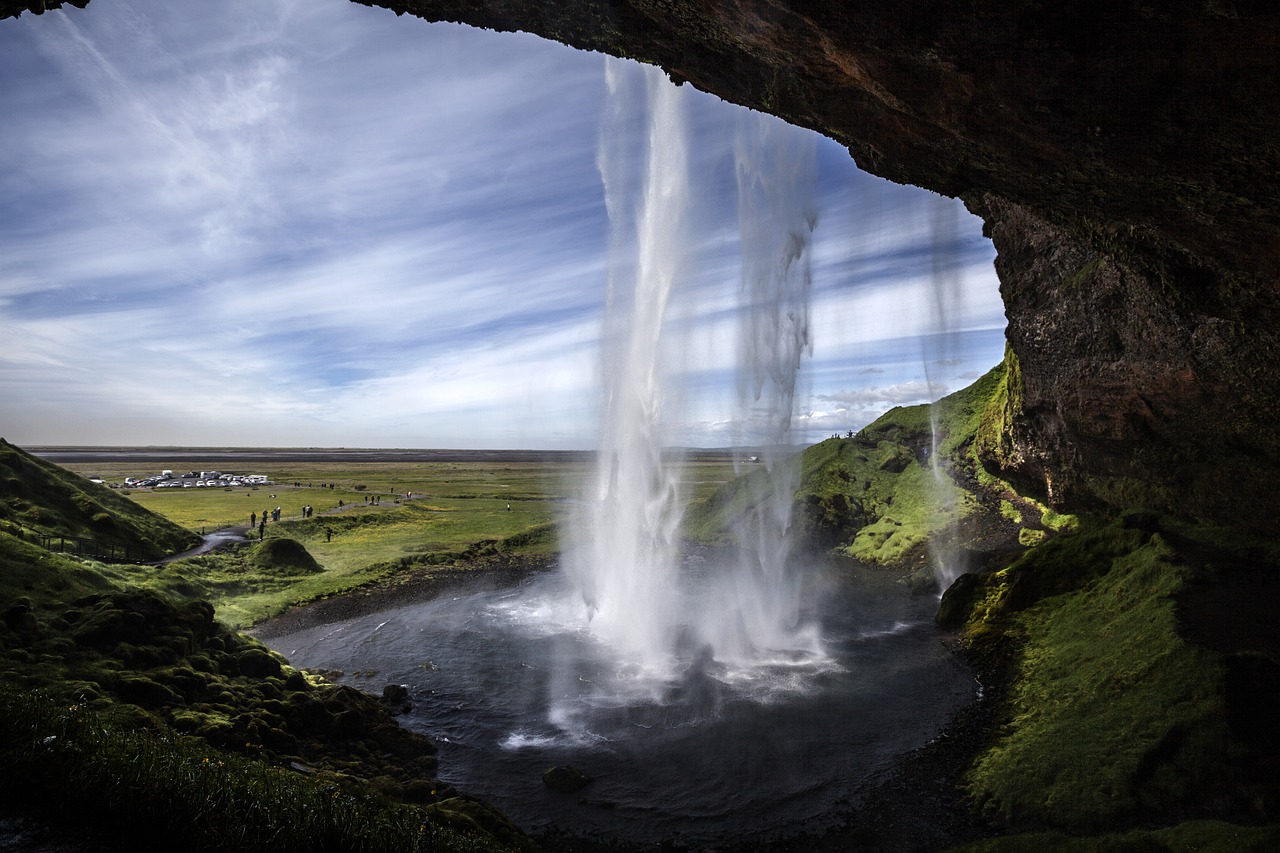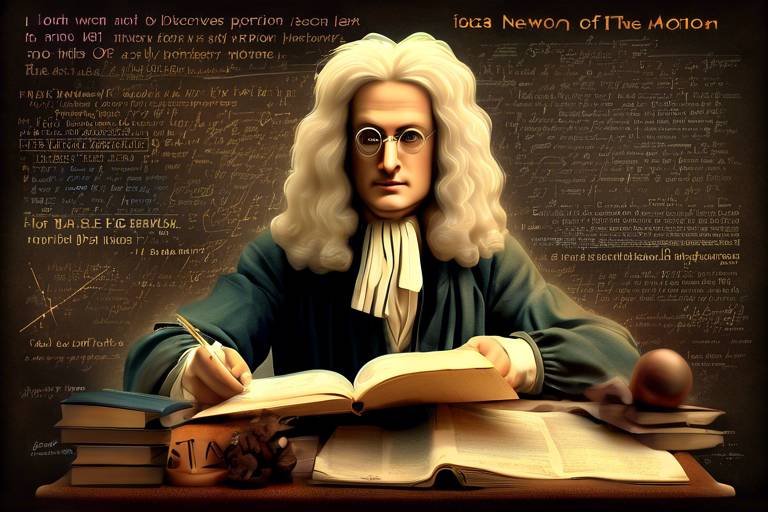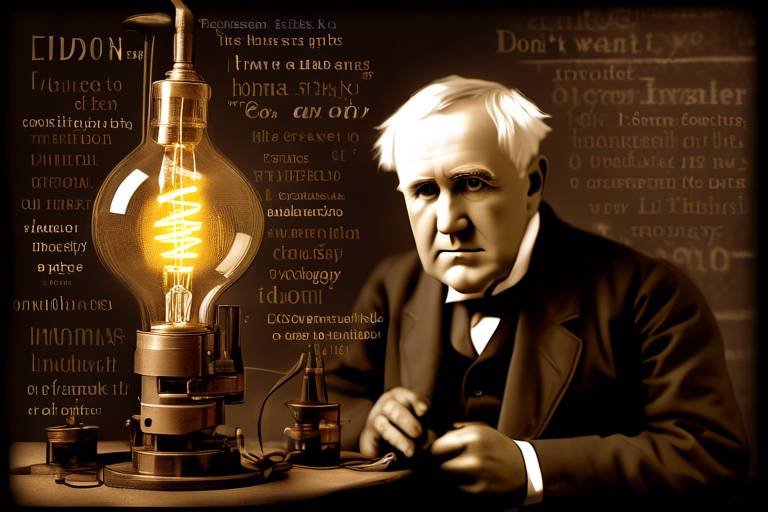The Discoveries of Isaac Newton and the Laws of Motion
Isaac Newton, a name that resonates through the corridors of science, is often considered the father of modern physics. His groundbreaking contributions to our understanding of the physical world have not only shaped the field of physics but have also influenced various other disciplines, including mathematics, astronomy, and engineering. Newton's laws of motion and the law of universal gravitation serve as the bedrock of classical mechanics, providing a framework that explains how objects move and interact with one another. Imagine standing on the edge of a cliff, watching a stone fall into the abyss below; Newton’s principles give you the tools to understand why it falls, how quickly it accelerates, and what forces are at play. This article will take you on a journey through Newton's life, his monumental discoveries, and their lasting impact on science and society.
Born on January 4, 1643, in Woolsthorpe, England, Isaac Newton's early life was marked by challenges and a relentless curiosity about the world around him. His family faced hardships, and he was raised by his grandmother after his father passed away when he was just three years old. Despite these obstacles, Newton's thirst for knowledge was insatiable. He enrolled at the University of Cambridge in 1661, where he was exposed to the works of great thinkers like Galileo and Descartes. It was during this time that his scientific thinking began to flourish. The university provided a fertile ground for his ideas, and he immersed himself in mathematics, physics, and astronomy, laying the groundwork for his future discoveries. The Great Plague of 1665 forced the university to close, but this setback turned into a blessing in disguise for Newton. He returned home, where he had the opportunity to contemplate the natural world in solitude, leading to some of his most significant breakthroughs.
One of Newton's most profound contributions to science was his formulation of the law of universal gravitation. This law states that every point mass attracts every other point mass in the universe with a force that is directly proportional to the product of their masses and inversely proportional to the square of the distance between them. In simpler terms, it means that the more massive an object, the stronger its gravitational pull, and the farther away two objects are from each other, the weaker the force of gravity between them. This principle not only explained why objects fall to the ground but also provided a framework for understanding the movements of celestial bodies. Imagine the planets dancing around the sun, held in their orbits by an invisible force; that’s gravity at work! The implications of this law extended beyond Earth, allowing astronomers to predict the movements of planets and moons with remarkable accuracy.
One of the most famous anecdotes associated with Newton is the story of the falling apple. Legend has it that while sitting under an apple tree, Newton observed an apple fall to the ground. This simple event sparked a profound realization about gravity and led him to ponder why objects always fall straight down. Was it merely a coincidence, or was there a force acting upon the apple? This moment of inspiration ignited a chain of thoughts that would culminate in the formulation of the law of universal gravitation. While the story may be embellished over time, it serves as a powerful reminder of how curiosity can lead to monumental discoveries.
To fully grasp the implications of his law of universal gravitation, Newton employed the mathematical principles of calculus, which he developed concurrently with his theories. The concept of the inverse square law is central to understanding gravitational force; it states that as the distance between two objects increases, the gravitational force decreases exponentially. This mathematical framework not only supports the law of gravitation but also allows scientists to calculate the gravitational effects of various celestial bodies. The beauty of mathematics, much like a symphony, harmonizes with the physical laws of the universe, creating a comprehensive understanding of motion and force.
Newton's three laws of motion are fundamental to our understanding of how objects behave in the physical world. These laws describe the relationship between the motion of an object and the forces acting upon it, forming the core of classical mechanics. They are not just theoretical constructs; they have practical applications in everything from engineering to sports. Let's delve into each law and explore their significance.
Newton's first law, often referred to as the law of inertia, states that an object at rest will remain at rest, and an object in motion will continue in motion with the same speed and in the same direction unless acted upon by an external force. This principle can be likened to a train on a track; once it’s moving, it takes a significant force to stop it. In everyday life, we experience inertia when we feel a jolt in our seats as a car accelerates or brakes suddenly. It highlights the importance of understanding forces in our daily interactions with the physical world.
The second law of motion introduces the iconic formula Fma, where F represents force, m represents mass, and a represents acceleration. This equation reveals the relationship between the force applied to an object and its resulting acceleration. If you’ve ever pushed a friend on a swing, you know that the harder you push (the greater the force), the faster they swing (the greater the acceleration). This law is essential in various fields, including engineering and sports, where understanding forces can lead to improved performance.
Newton's third law states that for every action, there is an equal and opposite reaction. This principle is evident in countless scenarios, from a rocket launching into space to the recoil felt when firing a gun. It's a beautiful dance of forces, where every push creates a pull, and every action has a consequence. Imagine jumping off a small boat; as you leap forward, the boat moves backward, illustrating this law in action.
Newton's discoveries revolutionized not only the field of physics but also our understanding of the universe itself. His laws of motion and universal gravitation laid the groundwork for future scientists, including Einstein, who built upon Newtonian concepts to develop the theory of relativity. Beyond physics, Newton's work influenced philosophy, engineering, and even the way we perceive our place in the cosmos. The principles he established continue to be taught in classrooms around the world, serving as a testament to the enduring legacy of his work. In a society increasingly driven by technology and scientific inquiry, Newton's contributions remind us of the power of curiosity and the importance of seeking answers to the fundamental questions of existence.
- What are Newton's three laws of motion? They are the law of inertia, the law of acceleration (Fma), and the law of action and reaction.
- How did Newton's law of universal gravitation change our understanding of the universe? It provided a mathematical framework to explain the gravitational forces acting between celestial bodies, allowing for predictions of their movements.
- What role did calculus play in Newton's discoveries? Calculus was essential for formulating his laws of motion and gravitation, enabling precise calculations of forces and motion.

Newton's Early Life and Education
Isaac Newton, one of the most influential scientists of all time, was born on January 4, 1643, in Woolsthorpe, England. His early life was marked by a series of challenges and triumphs that would ultimately shape his extraordinary intellect. Raised by his grandmother after his father passed away before he was born, Newton was somewhat of a solitary child. This solitude allowed him to cultivate a deep curiosity about the world around him, leading him to explore various subjects, including mathematics and natural philosophy.
Newton's formal education began at the King's School in Grantham, where he displayed a remarkable aptitude for learning. It was here that he was introduced to the works of great thinkers like Aristotle and Galileo, sparking his interest in science. However, his academic journey took a significant turn when he enrolled at the University of Cambridge in 1661. At Cambridge, Newton was exposed to the rigorous study of mathematics and physics, which would later serve as the bedrock of his groundbreaking theories.
During his time at Cambridge, Newton was particularly influenced by the teachings of Isaac Barrow, a prominent mathematician and theologian who recognized Newton's exceptional talent. Barrow encouraged him to delve deeper into the realms of calculus and optics. Despite the challenges posed by the Great Plague of 1665, which forced the university to close temporarily, Newton utilized this time to work independently, developing many of his revolutionary ideas. This period of intense focus and isolation was akin to a cocoon, allowing his thoughts to mature and evolve.
Newton's education was not solely confined to textbooks; he was a keen observer of nature and often conducted experiments to test his theories. For instance, he famously experimented with prisms, discovering that white light could be separated into a spectrum of colors. This hands-on approach to learning was crucial in shaping his scientific methodology, which emphasized observation and experimentation.
Overall, Newton's early life and education were characterized by a blend of isolation, curiosity, and intellectual rigor. These formative experiences laid the foundation for his later achievements, which would forever alter the course of science. His journey from a solitary child to a pioneering scientist is a testament to the power of education and the relentless pursuit of knowledge.

The Law of Universal Gravitation
The law of universal gravitation, formulated by Isaac Newton in the late 17th century, is one of the cornerstones of classical physics. This groundbreaking principle describes the gravitational force that exists between any two masses in the universe. It's fascinating to think about how this simple yet profound idea has shaped our understanding of everything from falling apples to the motion of planets. In essence, Newton proposed that every object attracts every other object with a force that is directly proportional to the product of their masses and inversely proportional to the square of the distance between them. This relationship can be mathematically expressed as:
F G * (m1 * m2) / r²
Where:
- F is the gravitational force between the two objects.
- G is the gravitational constant, approximately equal to 6.674 × 10-11 N(m/kg)2.
- m1 and m2 are the masses of the two objects.
- r is the distance between the centers of the two masses.
This law not only explains why objects fall to the ground but also provides insights into the orbits of planets, moons, and even the paths of comets. Imagine the universe as a grand dance floor, where every celestial body is a dancer influenced by the gravitational pull of others. The intricacies of this dance are governed by the very principles Newton laid out. For instance, the gravitational force between the Earth and the Moon is what keeps the Moon in orbit, while the Sun's gravity holds the Earth and other planets in their respective paths.
Moreover, the implications of the law of universal gravitation extend beyond just celestial mechanics. It has paved the way for advancements in various fields, including astronomy, engineering, and even space exploration. Without this understanding, our ability to send spacecraft to distant planets or to predict the behavior of satellites would be severely limited. The law serves as a reminder of how interconnected our universe is and how the forces at play can have profound effects across vast distances.
To illustrate the significance of Newton's law, consider the following table that summarizes its key components and implications:
| Component | Description |
|---|---|
| Gravitational Force (F) | The attractive force between two masses. |
| Mass (m1, m2) | The quantity of matter in the objects involved. |
| Distance (r) | The separation between the centers of the two masses. |
| Gravitational Constant (G) | A proportionality factor that makes the units work out. |
In summary, Newton's law of universal gravitation not only transformed our understanding of motion but also laid the groundwork for future scientific discoveries. It’s a testament to the power of human curiosity and intellect, showing us how even the simplest observations can lead to profound insights about the universe. As we continue to explore the cosmos, the principles established by Newton remain as relevant today as they were over 300 years ago.
- What is the law of universal gravitation? - It is a law that describes the gravitational attraction between two masses.
- How did Newton come up with this law? - Newton formulated the law based on observations of celestial bodies and the forces acting upon them.
- What are the implications of this law? - The law has significant implications for understanding planetary orbits, space travel, and the behavior of objects under the influence of gravity.

The Apple Incident
Ah, the infamous apple incident! This charming tale is often linked to the genius of Isaac Newton and serves as a delightful anecdote that illustrates the momentous spark that ignited his revolutionary ideas about gravity. Picture this: Newton, a young man with a curious mind, was sitting under an apple tree when he saw an apple fall to the ground. This seemingly mundane event made him ponder a profound question: Why do apples fall straight down instead of sideways or even upward? This simple observation led him to contemplate the forces at play in our universe, setting the stage for his groundbreaking discoveries.
But let’s not stop there! The apple wasn’t just a fruit; it became a symbol of enlightenment and curiosity. Newton's moment of inspiration was not merely about the apple itself, but rather the universal principles of motion it represented. The falling apple prompted him to think about the gravitational force that governs not just apples but planets, moons, and stars. It's a bit like a domino effect—one small observation can lead to monumental discoveries!
To understand the significance of this incident, we can break it down into a few key points:
- Inspiration: The apple served as the catalyst for Newton's theories, pushing him to think deeply about gravity.
- Curiosity: This moment exemplifies how a curious mind can transform ordinary experiences into extraordinary insights.
- Universal Application: Newton realized that the same force acting on the apple also applies to celestial bodies, linking terrestrial and cosmic phenomena.
Interestingly, while the story of the apple is widely known, it’s important to note that Newton himself never explicitly stated that he was inspired by a falling apple. This anecdote was popularized by later biographers who sought to illustrate his genius in a relatable way. Nevertheless, it serves as a powerful reminder that sometimes, the simplest observations can lead to the most profound scientific revelations. It’s a bit like finding a treasure map in your backyard—what seems ordinary at first can lead to extraordinary discoveries!
In conclusion, the apple incident encapsulates the essence of scientific inquiry: curiosity, observation, and the pursuit of knowledge. Newton's contemplations on that fateful day under the apple tree not only changed his life but also altered the course of science forever. It reminds us all to keep our eyes open to the world around us, for you never know when inspiration might strike!
- What did Isaac Newton discover about gravity?
Newton formulated the law of universal gravitation, explaining that every mass attracts every other mass in the universe. - Is the apple incident true?
While the story is widely shared, there is no direct evidence that Newton was inspired by a falling apple; it was popularized by later accounts. - How did Newton's laws impact science?
Newton's laws laid the groundwork for classical mechanics, influencing physics, engineering, and our understanding of the universe.

Mathematical Foundations
The mathematical principles that underpin Isaac Newton's law of universal gravitation are nothing short of revolutionary. At its core, this law can be expressed with a simple yet profound formula: F G * (m1 * m2) / r². Here, F represents the gravitational force between two masses, G is the gravitational constant, m1 and m2 are the two masses, and r is the distance between their centers. This equation not only describes the force of gravity but also highlights the inverse square nature of gravitational attraction. The further apart two objects are, the weaker the gravitational force between them becomes. This is akin to how the light from a distant star dims as it travels through the vastness of space.
Newton's genius wasn't just in formulating this law; it was also in his use of calculus to derive and explain it. He developed calculus independently around the same time as Gottfried Wilhelm Leibniz, and it became an essential tool for expressing changes in motion and understanding how forces interact with masses. Imagine trying to navigate a ship through turbulent waters without a map or compass; calculus was Newton's navigational tool, allowing him to chart the complexities of motion and force.
To grasp the significance of the inverse square law, consider this: if you double the distance between two objects, the gravitational force diminishes to a quarter of its original strength. This concept can be illustrated in a simple table:
| Distance (r) | Gravitational Force (F) |
|---|---|
| 1 unit | F |
| 2 units | F/4 |
| 3 units | F/9 |
This table clearly illustrates how gravitational force weakens with increasing distance, emphasizing the profound implications of Newton's findings on celestial mechanics. His work laid the groundwork for understanding not just earthly phenomena but also the movements of planets, moons, and stars in the cosmos.
In addition to calculus, Newton's mathematical framework also included the concept of limits, which are fundamental in understanding how quantities behave as they approach a certain value. This is particularly important in physics, where we often deal with objects in motion and the forces acting upon them. The elegance of Newton's mathematics allowed him to not only formulate laws but also predict the outcomes of various physical interactions, much like a skilled chess player anticipating their opponent's moves.
Ultimately, the mathematical foundations laid by Newton were not just tools for calculation; they were a new language for describing the universe. His ability to translate complex physical concepts into mathematical equations opened doors to advancements in physics and engineering that continue to resonate to this day. As we delve deeper into the universe, we often find ourselves using the very equations that Newton first penned down, proving that his influence extends far beyond his own time.
- What is the law of universal gravitation? It is a fundamental principle that describes the gravitational attraction between two masses, formulated by Isaac Newton.
- How did Newton develop calculus? Newton developed calculus independently as a means to understand and describe changes in motion and the effects of forces.
- What are the implications of the inverse square law? The inverse square law explains how gravitational force weakens as the distance between two objects increases, which is crucial for understanding celestial mechanics.
- Why is Newton's work still relevant today? Newton's laws and mathematical principles form the foundation of classical mechanics, influencing modern physics, engineering, and our understanding of the universe.

Newton's Three Laws of Motion
Isaac Newton's contributions to physics are monumental, and at the heart of his legacy are his Three Laws of Motion. These laws provide a fundamental framework for understanding how objects behave in response to forces. Imagine you're at a park, watching children play on swings. The way they move—starting, stopping, swinging back and forth—can be explained through these laws. Let's dive into each law and uncover the magic behind them!
The first law, often referred to as the law of inertia, states that an object at rest will stay at rest, and an object in motion will continue moving in a straight line at a constant speed unless acted upon by an external force. Think of it like a book lying on a table. It won’t move unless someone pushes it. This law highlights the natural tendency of objects to resist changes in their state of motion. In essence, inertia is the reason why you feel a jolt when a car suddenly accelerates or stops; your body wants to maintain its state of rest or motion!
Now, let’s talk about the second law, encapsulated in the famous equation Fma, where F represents force, m is mass, and a is acceleration. This law explains how the velocity of an object changes when it is subjected to an external force. For instance, if you push a shopping cart, the harder you push (greater force), the faster it accelerates. However, if the cart is loaded with heavy groceries (greater mass), it won’t accelerate as quickly as an empty cart with the same force. This relationship is crucial in various applications, from engineering to sports, demonstrating how forces impact motion.
Finally, we arrive at Newton's third law, which states that for every action, there is an equal and opposite reaction. Picture this: when you jump off a small boat onto a dock, you push down on the boat (action), causing it to move backward (reaction). This law reveals the interconnectedness of forces in our universe. It’s not just limited to jumping off boats; it applies to everything, from rockets launching into space to the way we walk. Each step we take pushes against the ground, and in return, the ground pushes us forward!
The implications of Newton's three laws extend far beyond the realm of physics. They laid the groundwork for classical mechanics, influencing countless fields such as engineering, astronomy, and even everyday activities. Without these laws, our understanding of motion and forces would be fundamentally different. From designing safer vehicles to predicting the orbits of planets, Newton's insights have shaped modern science and technology.
- What are Newton's three laws of motion? Newton's three laws of motion are: 1) An object at rest stays at rest, and an object in motion stays in motion unless acted upon by an external force (Inertia). 2) The force acting on an object is equal to the mass of that object times its acceleration (Fma). 3) For every action, there is an equal and opposite reaction.
- How do these laws apply in daily life? These laws can be observed in everyday activities, such as driving a car, riding a bicycle, or even playing sports, where forces and motion are constantly at play.
- Why are Newton's laws important? They provide a fundamental understanding of how objects move and interact, forming the basis for classical mechanics and influencing various scientific and engineering disciplines.

First Law: Inertia
Isaac Newton's First Law of Motion is often referred to as the law of inertia, and it fundamentally changed our understanding of how objects behave in motion. Simply put, this law states that an object at rest will remain at rest, and an object in motion will continue to move at a constant velocity in a straight line unless acted upon by an external force. This concept can be a bit mind-boggling at first, especially when we consider our everyday experiences. For instance, think about riding in a car: when the driver suddenly hits the brakes, your body lurches forward. Why? Because your body wants to keep moving at the same speed and direction. That's inertia in action!
Inertia is not just a fancy term; it's a fundamental property of matter. The greater the mass of an object, the greater its inertia. This means heavier objects are harder to start moving and harder to stop than lighter ones. Imagine trying to push a heavy boulder versus a small rock: the boulder will resist your efforts much more vigorously. This resistance to change in motion is what Newton captured in his First Law, and it has profound implications across various fields, from engineering to astrophysics.
To illustrate this concept further, consider the following table that summarizes the relationship between mass, inertia, and motion:
| Mass | Inertia | Effect on Motion |
|---|---|---|
| Low Mass | Low Inertia | Easy to accelerate and decelerate |
| High Mass | High Inertia | Requires more force to change motion |
This law not only applies to objects on Earth but also extends to celestial bodies in space. For example, a planet in orbit around the sun continues in its path due to its inertia, and it requires a significant force (like gravitational pull) to alter that trajectory. Understanding inertia has been crucial for scientists and engineers alike, allowing them to design everything from vehicles to spacecraft with precision.
In summary, Newton's First Law of Motion introduces us to the concept of inertia, a principle that governs the behavior of objects in motion. It challenges our intuitive understanding of motion and forces, emphasizing that without an external influence, things tend to keep doing what they are already doing. This realization not only laid the groundwork for classical mechanics but also opened the door to a deeper investigation of the forces that shape our universe.
- What is inertia? Inertia is the tendency of an object to resist changes in its state of motion.
- How does mass affect inertia? The greater the mass of an object, the greater its inertia, making it harder to change its motion.
- Can inertia be observed in everyday life? Absolutely! Common examples include a passenger leaning forward in a car when it stops suddenly or a ball rolling on the ground that eventually comes to a stop due to friction.

Second Law: F
This article explores Isaac Newton's groundbreaking contributions to physics, particularly his laws of motion and universal gravitation, which laid the foundation for classical mechanics and transformed our understanding of the physical world.
Isaac Newton, born in 1643, had a childhood that was anything but ordinary. Raised in Lincolnshire, England, he displayed a keen interest in nature and mechanics from a young age. His education at Cambridge University was pivotal, where he immersed himself in mathematics, physics, and astronomy. Newton's insatiable curiosity and intellect were nurtured during this time, leading him to question the very fabric of the universe around him.
Newton's formulation of the law of universal gravitation is a cornerstone of physics. This law articulates that every mass attracts every other mass in the universe, with a force that is directly proportional to the product of their masses and inversely proportional to the square of the distance between them. This profound insight not only explained why objects fall to the ground but also unveiled the intricate dance of celestial bodies in the cosmos.
One of the most famous anecdotes in science is the story of the falling apple. Legend has it that while sitting in his garden, Newton observed an apple fall from a tree. This simple event sparked a cascade of thoughts about gravity and motion. He pondered why the apple fell straight down rather than sideways or even upward, leading him to consider the forces that govern both earthly and celestial motion.
To truly grasp Newton's law of universal gravitation, one must appreciate the mathematical principles behind it. Newton's development of calculus was revolutionary, providing the tools necessary to describe change and motion quantitatively. The concept of inverse square laws, which states that the gravitational force diminishes as the distance between two masses increases, is fundamental in understanding gravitational interactions.
Newton's three laws of motion form the bedrock of classical mechanics. These laws describe how objects move and interact with forces, fundamentally shaping our understanding of the physical world. Each law builds upon the previous one, creating a comprehensive framework for analyzing motion.
Newton's first law, often referred to as the law of inertia, asserts that an object at rest will remain at rest, and an object in motion will continue in motion at a constant velocity, unless acted upon by an external force. This principle highlights the natural tendency of objects to resist changes in their state of motion, much like a car cruising down the highway that won’t stop unless the driver applies the brakes.
Newton's second law of motion is encapsulated in the equation Fma, where F represents force, m represents mass, and a represents acceleration. This relationship reveals how the force applied to an object is directly proportional to its mass and the acceleration produced. In simpler terms, the harder you push an object, the faster it will accelerate, but if that object is heavier, you'll need to exert even more force to achieve the same acceleration.
To illustrate this concept, consider the following scenarios:
- A small car (light mass) can accelerate quickly with a small force.
- A large truck (heavy mass) requires a much greater force to achieve the same acceleration.
This law is not just theoretical; it has practical implications in everyday life. For example, when playing sports, understanding how to apply force effectively can improve performance, whether you're kicking a soccer ball or throwing a basketball.
Newton's third law states that for every action, there is an equal and opposite reaction. This means that forces always come in pairs. If you push against a wall, the wall pushes back with equal force. This principle is evident in countless scenarios, from walking (where your foot pushes down on the ground and the ground pushes you upward) to rocket propulsion (where gases expelled downward propel the rocket upward).
Newton's discoveries revolutionized science, shaping not just physics but also philosophy and engineering. His laws of motion and universal gravitation provided a coherent framework for understanding the universe, influencing thinkers and scientists for centuries to come. Newton's work laid the groundwork for advancements in technology and our overall understanding of the cosmos, fundamentally altering our perception of reality.
- What is the significance of Newton's laws of motion? Newton's laws provide a fundamental understanding of how objects move and interact with forces, forming the basis of classical mechanics.
- How did Newton develop calculus? Newton developed calculus as a tool to describe change and motion, which was essential for formulating his laws of motion and universal gravitation.
- What was the impact of the apple incident? The apple incident symbolizes the moment of inspiration that led Newton to explore the concept of gravity, ultimately changing the course of science.

Third Law: Action and Reaction
Newton's third law of motion is one of those principles that seems simple at first glance but carries profound implications for our understanding of the universe. It states that for every action, there is an equal and opposite reaction. This means that whenever one object exerts a force on another, the second object exerts a force of equal magnitude but in the opposite direction on the first object. Think of it like a dance: when you push against your partner, they push back just as hard, keeping the rhythm of the dance alive.
To illustrate this concept, imagine standing on a skateboard. If you push off a wall, the wall pushes back against you with the same force, sending you rolling in the opposite direction. This is a clear, everyday example of Newton's third law in action. It’s not just an abstract idea; it’s something we experience continuously in our daily lives. Whether it’s walking, jumping, or even swimming, this law governs the interactions between our bodies and the forces around us.
In the realm of physics, this law has significant implications. For instance, consider how rockets launch into space. When the engines fire, they expel gas downwards with tremendous force. According to Newton's third law, the rocket experiences an equal and opposite force that propels it upwards, overcoming the force of gravity. Without this fundamental principle, our ability to explore the cosmos would be severely limited.
Moreover, the third law extends beyond just physical movement. It can also be seen in everyday interactions. When you sit on a chair, your body exerts a downward force due to gravity, and the chair responds with an equal force pushing upward, keeping you comfortably seated. This principle is also crucial in engineering and design, where understanding the forces at play ensures that structures can withstand various loads and stresses.
To summarize, Newton's third law of motion is a cornerstone of classical mechanics that explains how forces interact in our universe. Whether you’re launching a spacecraft or simply sitting down, the action-reaction principle is always at work, illustrating the interconnectedness of all physical phenomena.
- What is an example of Newton's third law in everyday life?
An example would be walking; as you push your foot backward against the ground, the ground pushes you forward. - How does Newton's third law apply to rocket propulsion?
Rockets work by expelling gas downwards, which creates an upward thrust due to the reaction force. - Can you provide a simple experiment to demonstrate this law?
Yes! Inflate a balloon and release it without tying it. The escaping air will propel the balloon in the opposite direction.

Impact on Science and Society
Isaac Newton's discoveries have had a profound and lasting impact on both science and society. His work not only reshaped the field of physics but also influenced various other domains, including mathematics, engineering, and philosophy. The principles he established laid the groundwork for modern scientific inquiry and revolutionized our understanding of the universe. Imagine standing on the shoulders of giants; Newton is one of those giants whose shoulders we continue to stand on today.
One of the most significant impacts of Newton's work is the way it transformed the scientific method. Before Newton, science was often based on philosophical reasoning and speculation. His emphasis on observation, experimentation, and mathematical reasoning brought a new rigor to the field. This shift allowed science to evolve into a systematic pursuit of knowledge, paving the way for future scientists to build upon his findings. In essence, Newton taught us that the universe operates according to specific laws, and those laws can be discovered and understood through careful study.
Newton’s laws of motion and universal gravitation also had profound implications for engineering and technology. The ability to predict the motion of objects led to advancements in various fields, including:
- Aerospace Engineering: Understanding gravitational forces is crucial for designing aircraft and spacecraft.
- Mechanical Engineering: Newton's laws are foundational for the analysis of machinery and structures.
- Automotive Engineering: The principles of motion and force are essential for vehicle design and safety features.
Moreover, Newton's influence extended beyond the realm of science into the fabric of society. His work encouraged a spirit of inquiry and skepticism, which are core tenets of the Enlightenment. This period marked a significant shift in human thought, promoting ideals such as reason, individualism, and empirical evidence. Newton’s contributions inspired countless thinkers, including philosophers like John Locke and Immanuel Kant, who integrated his scientific principles into their own theories about human understanding and the nature of reality.
In education, Newton’s principles are often one of the first topics introduced in physics classes around the world. His laws are not merely academic; they are the building blocks of our understanding of how everything from a falling apple to the orbits of planets operates. This educational legacy ensures that generations of students grasp the fundamental concepts of motion and force, fostering a new generation of scientists and engineers.
In summary, the impact of Isaac Newton on science and society is immeasurable. His discoveries opened the door to a deeper understanding of the physical world, inspiring future generations to explore, question, and innovate. The laws of motion and universal gravitation are not just scientific principles; they are part of the very fabric of our understanding of existence. As we continue to explore the cosmos and unravel the mysteries of our universe, we do so with the knowledge and insights that Newton so brilliantly provided.
1. What were Isaac Newton's main contributions to science?
Newton's primary contributions include the laws of motion and the law of universal gravitation. These principles form the foundation of classical mechanics and explain how objects move and interact with forces.
2. How did Newton's work influence modern science?
Newton's emphasis on observation and mathematical reasoning revolutionized the scientific method, encouraging future scientists to rely on empirical evidence and experimentation.
3. Why is Newton often referred to as a "giant" in science?
Newton is considered a giant in science because his discoveries laid the groundwork for much of modern physics and influenced various fields, including mathematics, engineering, and philosophy.
Frequently Asked Questions
- What are Isaac Newton's most significant contributions to science?
Isaac Newton is best known for formulating the laws of motion and the law of universal gravitation. His work laid the groundwork for classical mechanics, explaining how objects move and interact with forces. These contributions transformed our understanding of the physical world and influenced various scientific disciplines.
- How did Newton's early life influence his scientific thinking?
Newton's early life, particularly his education at Cambridge University, played a crucial role in shaping his scientific curiosity. He was deeply influenced by the works of previous scientists and philosophers, which ignited his passion for exploring the natural world and understanding the principles governing it.
- What is the law of universal gravitation?
The law of universal gravitation states that every mass attracts every other mass with a force that is directly proportional to the product of their masses and inversely proportional to the square of the distance between their centers. This principle explains not only why apples fall from trees but also how planets orbit the sun!
- What is the story behind the falling apple?
The famous anecdote of the falling apple suggests that it was this simple event that inspired Newton to consider why objects fall to the ground. It led him to ponder the forces at play, ultimately resulting in his formulation of the law of universal gravitation.
- Can you explain Newton's three laws of motion?
Sure! Newton's three laws of motion are:
- First Law (Inertia): An object at rest stays at rest, and an object in motion stays in motion unless acted upon by an external force.
- Second Law (Fma): The acceleration of an object is directly proportional to the net force acting on it and inversely proportional to its mass.
- Third Law (Action and Reaction): For every action, there is an equal and opposite reaction, meaning forces always come in pairs.
- How did Newton's discoveries impact society?
Newton's discoveries revolutionized not just science but also philosophy and engineering. His laws provided a framework that allowed for advancements in technology, navigation, and even the way we understand the universe today. His impact is felt across various fields, showcasing the interconnectedness of scientific knowledge.



















